Huffman Prairie
Aerospace museums in OhioAirports established in 1904Airports on the National Register of Historic PlacesBiographical museums in OhioDayton Aviation Heritage National Historical Park ... and 10 more
Fairborn, OhioHistory of Dayton, OhioMuseums in Greene County, OhioNational Historic Landmarks in OhioNational Register of Historic Places in Greene County, OhioProtected areas of Greene County, OhioTransportation buildings and structures on the National Register of Historic Places in OhioUse mdy dates from April 2012Wright-Patterson Air Force BaseWright brothers

Huffman Prairie, also known as Huffman Prairie Flying Field or Huffman Field is part of Ohio's Dayton Aviation Heritage National Historical Park. The 84-acre (34-hectare) patch of rough pasture, near Fairborn, northeast of Dayton, is the place where the Wright brothers (Wilbur and Orville) undertook the task of creating a dependable, fully controllable airplane and training themselves to be pilots. Many early aircraft records were set by the Wrights at the Huffman Prairie.
Excerpt from the Wikipedia article Huffman Prairie (License: CC BY-SA 3.0, Authors, Images).Huffman Prairie
Pylon Road, Bath Township
Geographical coordinates (GPS) Address Nearby Places Show on map
Geographical coordinates (GPS)
| Latitude | Longitude |
|---|---|
| N 39.803333333333 ° | E -84.065833333333 ° |
Address
Pylon Road
45433 Bath Township
Ohio, United States
Open on Google Maps







